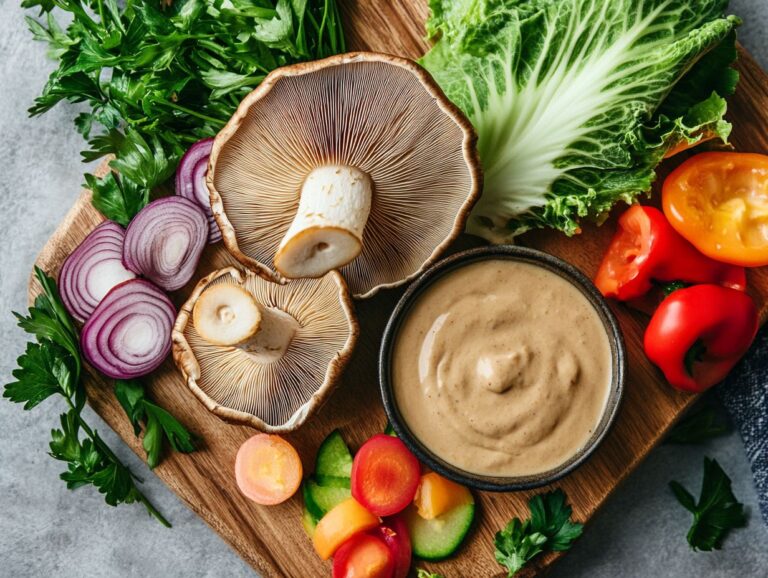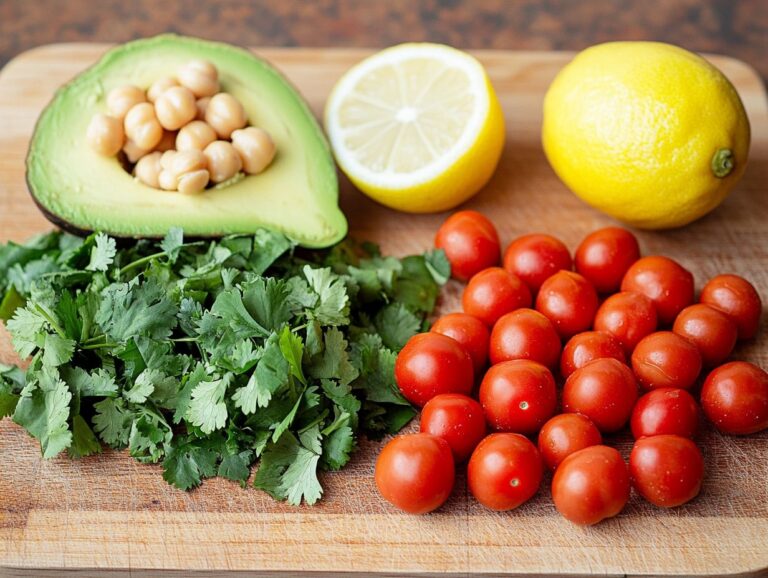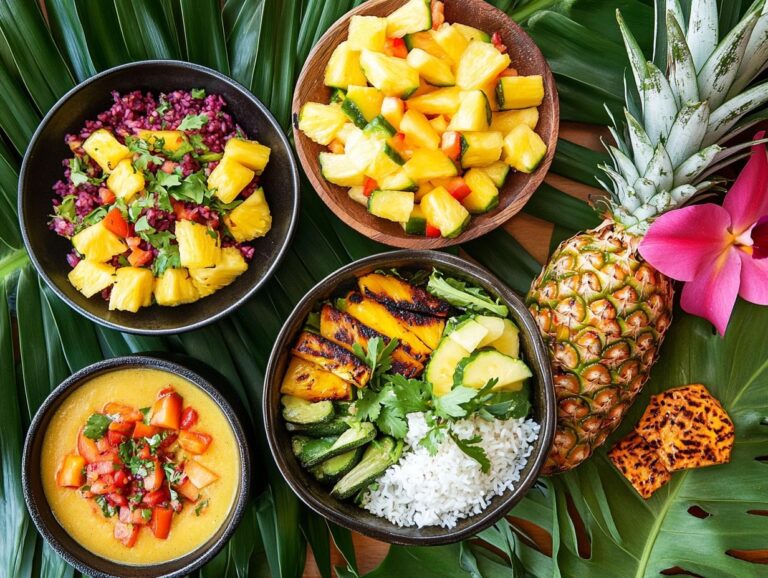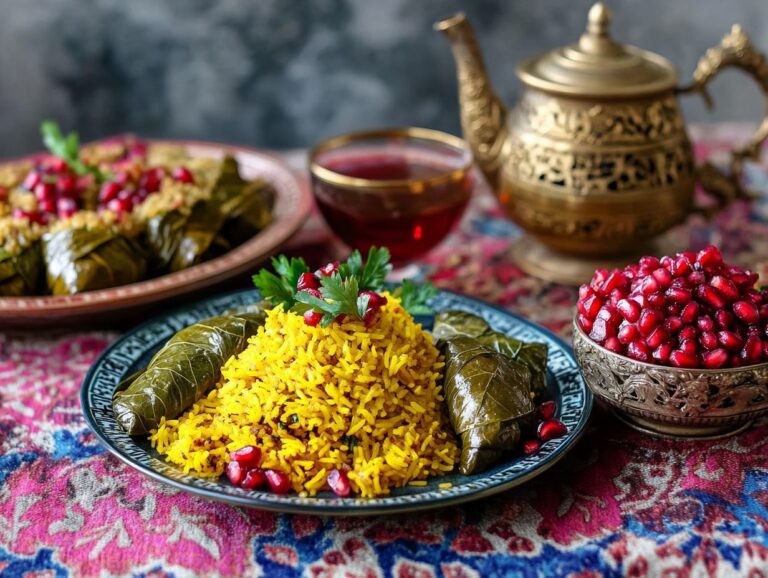Cambodian cuisine is a vibrant tapestry of flavors, deeply rooted in history and influenced by various cultures. This discussion highlights the traditional ingredients that define Cambodian cooking, focusing on the common spices, herbs, and vegetables that contribute to its distinctive taste. For those embracing a plant-based lifestyle, there are delicious vegan substitutes for traditional meat and fish dishes. Furthermore, you will discover authentic vegan recipes to try at home, along with tips for perfectly balancing the sweet, sour, and spicy notes that make Cambodian food so irresistible.
The History and Influences of Cambodian Food
 The history and influences of Cambodian food reflect a rich tapestry of cultural traditions, historical events, and agricultural practices shaped by the nation s environment and climate. From the ancient times of the Khmer Empire, known for its exceptional culinary techniques, to the modern era where global influences blend with local flavors, Cambodian cuisine has evolved into a unique culinary journey that emphasizes the importance of vegetables, rice, coconut milk, and Khmer noodles. Understanding this background allows us to appreciate the complexities of traditional dishes such as Nom Banh Chok, and the ongoing efforts to promote healthy eating and food security through community programs, including initiatives by Plan International. The evolution of Cambodian food can be traced through various dynasties, trade routes, and interactions with neighboring countries. Influences from Chinese, Thai, and Indian cuisines have introduced a variety of spices and cooking methods, making Cambodian dishes distinctively flavorful. Essential ingredients such as fish sauce, fresh herbs, and palm sugar play key roles in creating the vibrant flavors typical of dishes like Lok Lak, a stir-fried beef served with lime and pepper, and Amok, a fragrant fish curry steamed in banana leaves. These ingredients not only enhance taste but also reflect the agricultural wealth and biodiversity of the region, showcasing how historical interactions and local resources continue to define and enrich Cambodian culinary practices.
The history and influences of Cambodian food reflect a rich tapestry of cultural traditions, historical events, and agricultural practices shaped by the nation s environment and climate. From the ancient times of the Khmer Empire, known for its exceptional culinary techniques, to the modern era where global influences blend with local flavors, Cambodian cuisine has evolved into a unique culinary journey that emphasizes the importance of vegetables, rice, coconut milk, and Khmer noodles. Understanding this background allows us to appreciate the complexities of traditional dishes such as Nom Banh Chok, and the ongoing efforts to promote healthy eating and food security through community programs, including initiatives by Plan International. The evolution of Cambodian food can be traced through various dynasties, trade routes, and interactions with neighboring countries. Influences from Chinese, Thai, and Indian cuisines have introduced a variety of spices and cooking methods, making Cambodian dishes distinctively flavorful. Essential ingredients such as fish sauce, fresh herbs, and palm sugar play key roles in creating the vibrant flavors typical of dishes like Lok Lak, a stir-fried beef served with lime and pepper, and Amok, a fragrant fish curry steamed in banana leaves. These ingredients not only enhance taste but also reflect the agricultural wealth and biodiversity of the region, showcasing how historical interactions and local resources continue to define and enrich Cambodian culinary practices.
Traditional Ingredients in Cambodian Cooking
The traditional ingredients used in Cambodian cooking are as diverse as the country’s rich culinary heritage, showcasing a variety of fresh and seasonal vegetables that reflect Cambodia’s agricultural bounty. Staples like rice, along with unique ingredients such as coconut milk and ginger, play crucial roles in developing the flavor profiles of beloved dishes, while soy sauce adds depth to many recipes. These ingredients not only highlight the offerings available in local markets but also symbolize the country s commitment to food security and healthy eating practices.
Common Spices, Herbs, and Vegetables
Common spices, herbs, and vegetables play a vital role in Cambodian cuisine, contributing to the distinct flavors that define traditional dishes. Ingredients such as lemongrass, garlic, and chili create a harmonious balance of sweet, sour, and spicy flavors characteristic of Khmer food. These fresh herbs and locally sourced vegetables not only enhance the taste of meals but also support nutritional needs and emphasize the cultural significance of communal dining. Incorporating ingredients like galangal, turmeric, and fish sauce adds further complexity to many recipes. For instance, the aromatic combination of lemongrass and garlic serves as a base for soups and stir-fries, while chili adds a kick to popular dishes such as Khmer curry. Seasonal vegetables like water spinach and eggplant are frequently found in local markets, reflecting a commitment to fresh, sustainable produce.
Vegan Substitutes for Cambodian Dishes
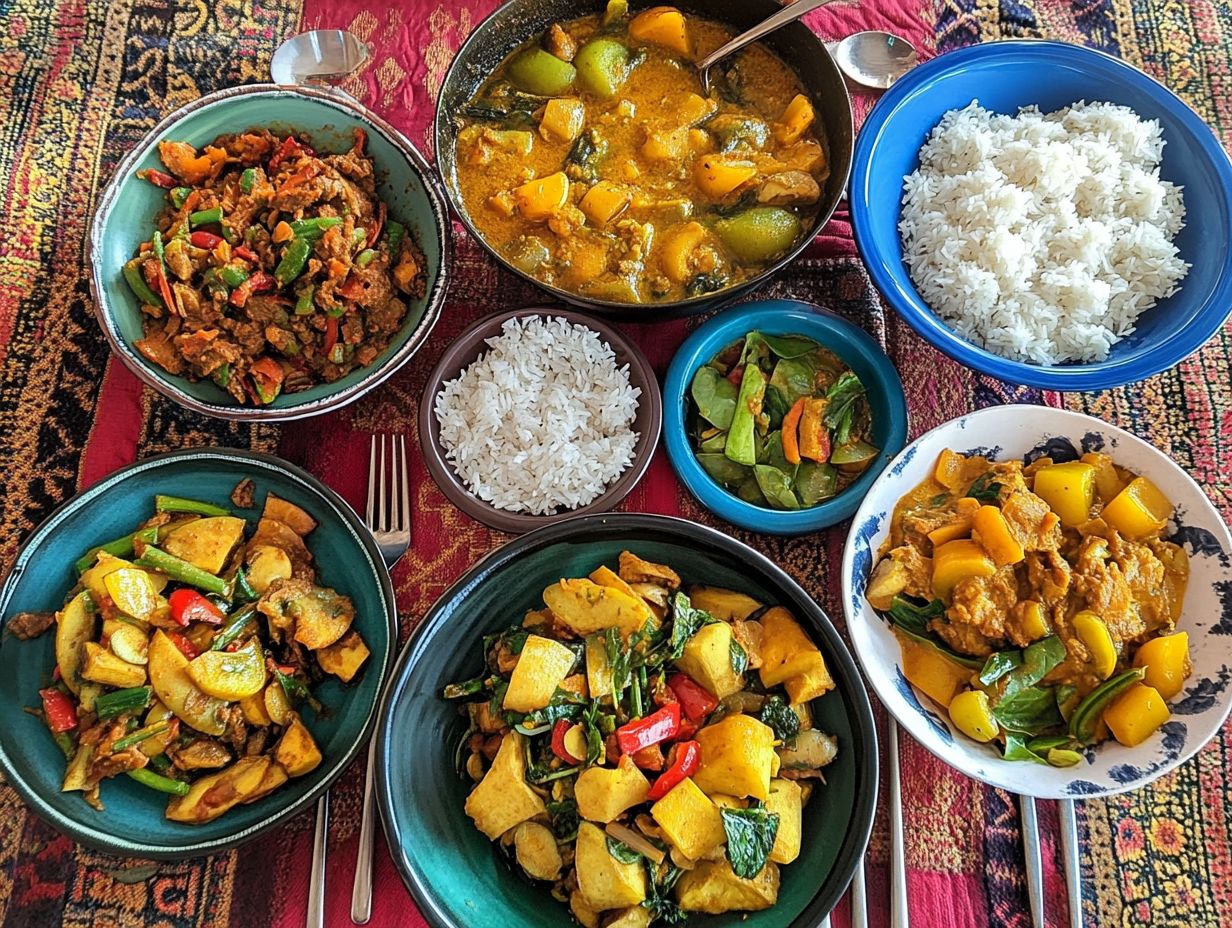 Vegan substitutes for traditional Cambodian dishes provide a modern twist on classic recipes while maintaining the essence of Khmer cuisine. Ingredients like tofu serve as versatile plant-based alternatives that can mimic the texture and flavor of meat and fish, enabling the creation of delicious vegan versions of traditional meals. This adaptation not only meets the increasing demand for healthy eating options but also promotes inclusivity within the culinary community, particularly during gatherings centered on girls’ rights and equality.
Vegan substitutes for traditional Cambodian dishes provide a modern twist on classic recipes while maintaining the essence of Khmer cuisine. Ingredients like tofu serve as versatile plant-based alternatives that can mimic the texture and flavor of meat and fish, enabling the creation of delicious vegan versions of traditional meals. This adaptation not only meets the increasing demand for healthy eating options but also promotes inclusivity within the culinary community, particularly during gatherings centered on girls’ rights and equality.
Plant-Based Alternatives for Meat and Fish
Plant-based substitutes for meat and fish in Cambodian diets provide innovative and nutritious options for traditional dishes. Tofu, which can be stir-fried or grilled, absorbs the flavors of spices and sauces while maintaining its high nutritional value. These alternatives enhance traditional Cambodian cuisine by offering choices that cater to individual dietary preferences, supporting the philosophy of inclusivity especially during significant events like the International Day of the Girl, celebrated on October 11, promoting girls’ rights and equality. Tempeh is a thicker alternative to tofu, featuring a robust texture and nutty flavor that can be used in dishes such as Lok Lak. It can be marinated in a mixture of lime juice and garlic, then pan-fried until it turns brown and crispy. Shiitake mushrooms, known for their strong umami flavor, can add depth to meat-based stir-fries or soups without the need for animal products. Similarly, curries that typically require coconut milk for a creamy texture can be adapted to use plant-based alternatives.
Authentic Vegan Cambodian Recipes
Authentic vegan Cambodian recipes beautifully blend traditional flavors with plant-based ingredients, showcasing the versatility and richness of Khmer cuisine. These recipes can be part of a delightful brunch or holiday meal, providing meal inspirations that celebrate the diverse culinary traditions of Cambodia. Dishes such as Stir-Fried Lemongrass Tofu and Coconut Curry Vegetables not only delight the palate but also align with modern dietary needs that promote health and sustainability. These recipes enhance the food community’s focus on healthy eating and food security, while also providing culinary enthusiasts with a gateway to the vibrant flavors of Cambodia.
Stir-Fried Lemongrass Tofu
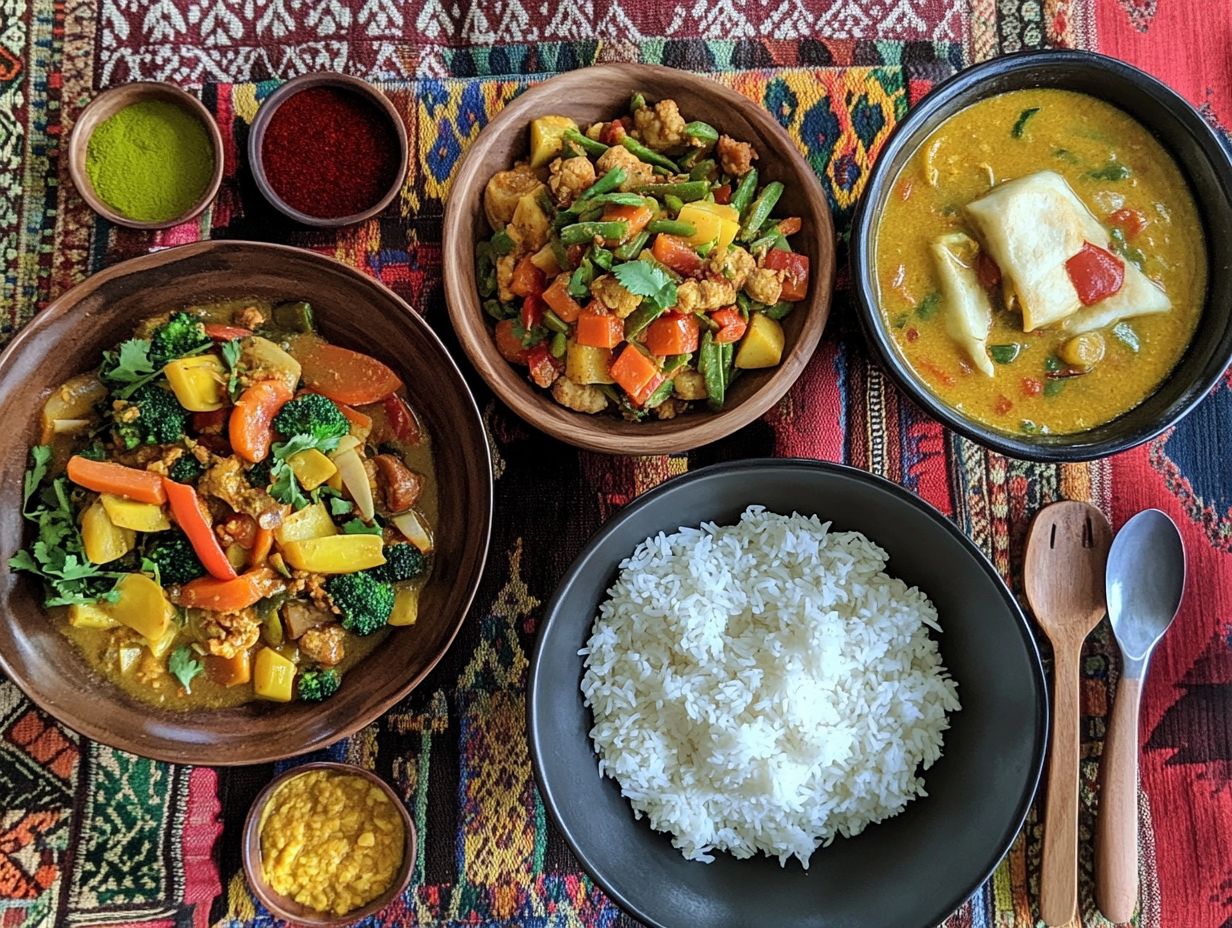 This Stir-Fried Lemongrass Tofu is a simple yet flavorful vegan dish that highlights the beauty of Cambodian cuisine through its use of uncomplicated but impactful ingredients. Featuring fresh lemongrass, tofu, and seasonal vegetables like pineapple, this recipe results in a dish that is both enjoyable and nutritious. It showcases the culinary richness of Khmer cuisine while promoting plant-based dietary practices. The primary ingredients for this dish include firm tofu, stalks of aromatic fresh lemongrass, bell peppers, carrots, and a handful of bok choy. For those looking to explore more, consider adding ginger or soy sauce to elevate the dish’s complexity. To prepare the dish, start by cutting the tofu into small cubes and marinating them in a mixture of soy sauce, lime juice, and a touch of maple syrup. Next, heat oil in a skillet or wok and add the chopped lemongrass. Once it becomes fragrant, add the marinated tofu and vegetables, stirring continuously until the vegetables are cooked but still crunchy. Optional ingredients include chili flakes or powder for added heat, or coconut milk for creaminess. This dish is filling and brings the authentic taste of Cambodia to the vegan table.
This Stir-Fried Lemongrass Tofu is a simple yet flavorful vegan dish that highlights the beauty of Cambodian cuisine through its use of uncomplicated but impactful ingredients. Featuring fresh lemongrass, tofu, and seasonal vegetables like pineapple, this recipe results in a dish that is both enjoyable and nutritious. It showcases the culinary richness of Khmer cuisine while promoting plant-based dietary practices. The primary ingredients for this dish include firm tofu, stalks of aromatic fresh lemongrass, bell peppers, carrots, and a handful of bok choy. For those looking to explore more, consider adding ginger or soy sauce to elevate the dish’s complexity. To prepare the dish, start by cutting the tofu into small cubes and marinating them in a mixture of soy sauce, lime juice, and a touch of maple syrup. Next, heat oil in a skillet or wok and add the chopped lemongrass. Once it becomes fragrant, add the marinated tofu and vegetables, stirring continuously until the vegetables are cooked but still crunchy. Optional ingredients include chili flakes or powder for added heat, or coconut milk for creaminess. This dish is filling and brings the authentic taste of Cambodia to the vegan table.
Coconut Curry Vegetables
Coconut Curry Vegetables is a delightful vegan dish that showcases an array of fresh vegetables cooked in coconut milk with aromatic spices. This traditional Cambodian recipe exemplifies the Khmer culinary love for balancing sweet and savory flavors, illustrating the harmonious blend of sweet and sour notes that define Cambodian culinary traditions. Not only is this dish comforting, but it is also healthy, offering a wide variety of fresh vegetables that provide numerous vitamins and minerals. The vibrant colors of the vegetables, such as bell peppers, carrots, and broccoli, make the dish visually appealing, a feast for both the eyes and palate. The cooking method involves saut ing the vegetables quickly until they are tender, after which they soak in the coconut milk along with garlic, ginger, and curry powder. This dish is typically served with steamed jasmine rice or quinoa, making it not only visually attractive but also very filling.
Green Mango Salad
Green Mango Salad is a delicious vegan dish that highlights the tart flavor of raw mangoes, combined with a tangy dressing and crunchy vegetables. This salad embodies the essence of Cambodian cuisine, emphasizing the balance of flavors through fresh herbs and traditional ingredients. It serves as a wonderful side dish or a light meal. To prepare this vibrant salad, add finely shredded green mangoes, colorful carrots, and aromatic herbs such as cilantro and mint. The dressing typically includes lime juice, sugar, and a hint of chili, creating layers of flavor that tantalize the taste buds. This dish not only encourages healthy eating with its fresh vegetables, promoting nutrition and wellness, but also reflects the culinary traditions of Southeast Asia, where the mixing of textures and tastes is essential. Enjoying this salad can evoke a sense of nostalgia, reminiscent of the bustling local markets of Cambodia, where such delightful food experiences and flavors thrive.
Banana Blossom Salad
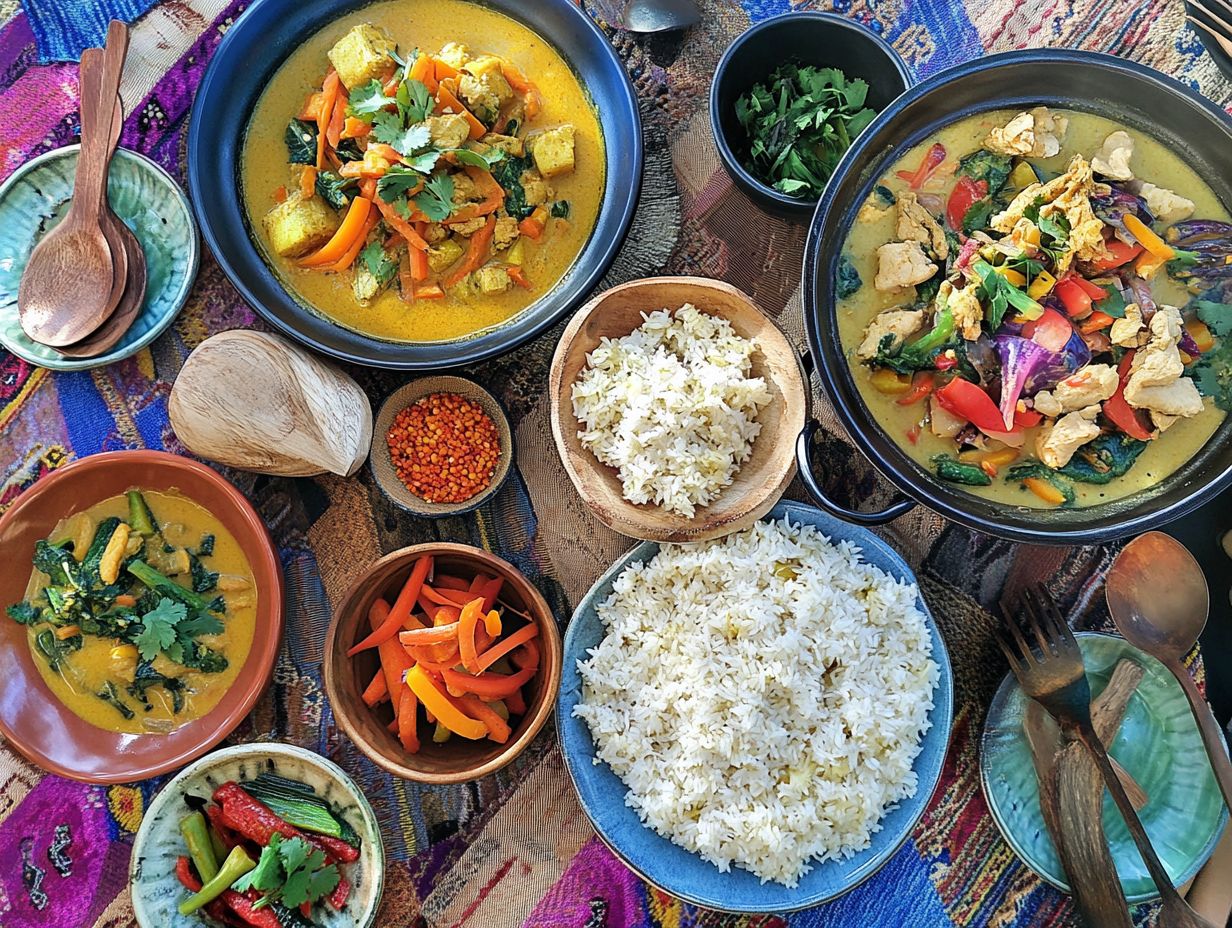 Banana Blossom Salad is a healthy vegetarian dish that showcases the unique texture and flavor of banana blossoms, complemented by a variety of fresh vegetables and dressing. It’s perfect for those looking for nutritious meal prep ideas or exploring vibrant vegetarian dishes. This dish exemplifies Khmer cuisine by utilizing fresh and nutritious ingredients, resulting in a meal that is both healthy and well-balanced. Visually stunning with its vibrant colors, the salad reflects Cambodian culture, where family meals are treasured and shared. The combination of shredded carrots, cucumbers, and herbs with banana blossoms not only enhances the flavor but also adds to its nutritional value. The dressing, made with lime juice, fish sauce, and chili, elevates the freshness of the dish and adds a zesty kick. Whether served as a side or main course, this salad is a favorite in Khmer cuisine, celebrated for its simplicity, health benefits, and delicious taste.
Banana Blossom Salad is a healthy vegetarian dish that showcases the unique texture and flavor of banana blossoms, complemented by a variety of fresh vegetables and dressing. It’s perfect for those looking for nutritious meal prep ideas or exploring vibrant vegetarian dishes. This dish exemplifies Khmer cuisine by utilizing fresh and nutritious ingredients, resulting in a meal that is both healthy and well-balanced. Visually stunning with its vibrant colors, the salad reflects Cambodian culture, where family meals are treasured and shared. The combination of shredded carrots, cucumbers, and herbs with banana blossoms not only enhances the flavor but also adds to its nutritional value. The dressing, made with lime juice, fish sauce, and chili, elevates the freshness of the dish and adds a zesty kick. Whether served as a side or main course, this salad is a favorite in Khmer cuisine, celebrated for its simplicity, health benefits, and delicious taste.
Tips for Perfecting Cambodian Flavors
To perfect Cambodian flavors, it is essential to achieve a harmonious balance of the sweet, sour, and spicy elements that characterize Khmer cuisine, which is a pivotal part of Cambodian culinary traditions. Mastering this balance requires a deep understanding of the cooking techniques and ingredients specific to each dish, such as using coconut milk and Khmer noodles to achieve the authentic taste of Cambodian food.
Techniques for Balancing Sweet, Sour, and Spicy
Balancing sweet, sour, and spicy flavors is essential for preparing authentic Cambodian dishes that reflect the rich and diverse depths of Khmer cuisine. By understanding how each ingredient contributes to the overall profile of a dish such as the sweetness from coconut milk or the heat from chili cooks can achieve the perfect balance, which is key in Cambodian culinary traditions. Mastering these flavor-balancing techniques allows home cooks to add depth to their culinary creations while honoring the rich traditions of Cambodian food, including experimenting with plant-based options like tofu and seasonal vegetables. One effective way to balance these flavors is by incorporating palm sugar, which adds sweetness, alongside fish sauce for saltiness. The combination of these two components creates a delightful interplay of flavors. Additionally, tamarind paste can introduce a notable sourness that brightens the meal. A prime example of this balance can be seen in the dish Amok, where the richness of coconut cream is complemented by lime juice, while minced chilies provide a flavorful kick. For those interested in vegan options, tofu can be substituted for meat in traditional recipes. For home cooks, it is advisable to practice by adding small amounts of each component and tasting until the desired balance is achieved. Furthermore, understanding the timing of adding spices and herbs can significantly impact the flavor of a dish. Herbs, for instance, should be added at the end of cooking, as they tend to lose their flavor when cooked for extended periods. Cooking methods like using an air fryer can also help in achieving a healthier version of classic Cambodian recipes.
